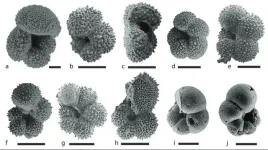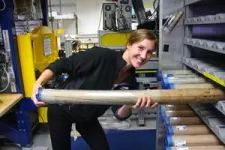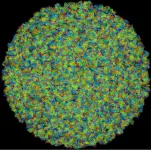(Press-News.org) When it comes to the ocean’s response to global warming, we’re not in entirely uncharted waters. A UC Riverside study shows that episodes of extreme heat in Earth’s past caused the exchange of waters from the surface to the deep ocean to decline.
This system has been described as the "global conveyer belt," because it redistributes heat around the globe through the movement of the ocean waters, making large portions of the planet habitable.
Using tiny, fossilized shells recovered from ancient deep-sea sediments, the study in the Proceedings of the National Academy of Sciences demonstrates how the conveyor belt responded around 50 million years ago. At that time, Earth’s climate resembled conditions predicted by the end of this century, if significant action is not taken to reduce carbon emissions.
Oceans play a crucial role in regulating Earth’s climate. They move warm water from the equator toward the north and south poles, balancing the planet’s temperatures. Without this circulation system, the tropics would be much hotter and the poles much colder. Changes in this system are linked to significant and abrupt climate change.
Furthermore, the oceans serve a critical role in removing anthropogenic carbon dioxide from the atmosphere. “The oceans are by far the largest standing pool of carbon on Earth’s surface today,” said Sandra Kirtland Turner, vice-chair of UCR’s Department of Earth and Planetary Sciences and first author of the study.
“Today, the oceans contain nearly 40,000 billion tons of carbon — more than 40 times the amount of carbon in the atmosphere. Oceans also take up about a quarter of anthropogenic CO2 emissions,” Kirtland Turner said. “If ocean circulation slows, absorption of carbon into the ocean may also slow, amplifying the amount of CO2 that stays in the atmosphere.”
Previous studies have measured changes in ocean circulation in Earth’s more recent geologic past, such as coming out of the last ice age; however, those do not approximate the levels of atmospheric CO2 or warming happening to the planet today. Other studies provide the first evidence that deep ocean circulation, particularly in the North Atlantic, is already starting to slow.
To better predict how ocean circulation responds to greenhouse gas-driven global warming, the research team looked to the early Eocene epoch, between roughly 49 and 53 million years ago. Earth then was much warmer than today, and that high-heat baseline was punctuated by spikes in CO2 and temperature called hyperthermals.
During that period, the deep ocean was up to 12 degrees Celsius warmer than it is today. During the hyperthermals, the oceans warmed an additional 3 degrees Celsius.
“Though the exact cause of the hyperthermal events is debated, and they occurred long before the existence of humans, these hyperthermals are the best analogs we have for future climate change,” Kirtland Turner said.
By analyzing tiny fossil shells from different sea floor locations around the globe, the researchers reconstructed patterns of deep ocean circulation during these hyperthermal events. The shells are from microorganisms called foraminifera, which can be found living throughout the world’s oceans, both on the surface and on the sea floor. They are about the size of a period at the end of a sentence.
“As the creatures are building their shells, they incorporate elements from the oceans, and we can measure the differences in the chemistry of these shells to broadly reconstruct information about ancient ocean temperatures and circulation patterns,” Kirtland Turner said.
The shells themselves are made of calcium carbonate. Oxygen isotopes in the calcium carbonate are indicators of temperatures in the water the organisms grew in, and the amount of ice on the planet at the time.
The researchers also examined carbon isotopes in the shells, which reflect the age of the water where the shells were collected, or how long water has been isolated from the ocean surface. In this way, they can reconstruct patterns of deep ocean water movement.
Foraminifera can’t photosynthesize, but their shells indicate the impact of photosynthesis of other organisms nearby, like phytoplankton. “Photosynthesis occurs in the surface ocean only, so water that has recently been at the surface has a carbon-13 rich signal that is reflected in the shells when that water sinks to the deep ocean,” Kirtland Turner said.
“Conversely, water that has been isolated from the surface for a long time has built up relatively more carbon-12 as the remains of photosynthetic organisms sink and decay. So, older water has relatively more carbon-12 compared to ‘young’ water.”
Scientists often make predictions about ocean circulation today using computer climate models. They use these models to answer the question: ‘how is the ocean going to change as the planet keeps warming?’ This team similarly used models to simulate the ancient ocean’s response to warming. They then used the foraminifera shell analysis to help test results from their climate models.
During the Eocene, there were about 1,000 parts per million (ppm) of carbon dioxide in the atmosphere, which contributed to that era’s high temperatures. Today, the atmosphere holds about 425 ppm.
However, humans emit nearly 37 billion tons of CO2 into the atmosphere each year; if these emission levels continue, similar conditions to the Early Eocene could occur by the end of this century.
Therefore, Kirtland Turner argues it is imperative to make every effort to reduce emissions.
“It’s not an all-or-nothing situation,” she said. “Every incremental bit of change is important when it comes to carbon emissions. Even small reductions of CO2 correlate to less impacts, less loss of life, and less change to the natural world.”
END
Ancient ocean slowdown warns of future climate chaos
Ocean circulation enables tolerable climate
2024-06-13
ELSE PRESS RELEASES FROM THIS DATE:
Pre-operative use of GLP-1s may reduce complications after metabolic and bariatric surgery in patients with extreme obesity
2024-06-13
SAN DIEGO – June 13, 2024 – A combination of GLP-1 agonists taken before metabolic and bariatric surgery may help patients with extreme obesity lower the risk of post-operative complications, according to a new study* presented today at the American Society for Metabolic and Bariatric Surgery (ASMBS) 2024 Annual Scientific Meeting
Patients with extreme obesity, a body mass index (BMI) of 70 or more, face a higher risk of complications from surgery compared to patients with lower BMIs. Studies have shown weight loss before surgery can mitigate risk but lifestyle intervention ...
Why many lung cancer patients who have never smoked have worse outcomes
2024-06-13
The reason why targeted treatment for non-small cell lung cancer fails to work for some patients, particularly those who have never smoked, has been discovered by researchers from UCL, the Francis Crick Institute and AstraZeneca.
The study, published in Nature Communications, shows that lung cancer cells with two particular genetic mutations are more likely to double their genome, which helps them to withstand treatment and develop resistance to it.
In the UK, lung cancer is the third most common type of cancer and the leading cause of cancer death. Around 85% of patients with lung cancer have non-small cell lung cancer (NSCLC), and this is the most common type found in patients ...
APA poll finds younger workers feel stressed, lonely and undervalued
2024-06-13
Younger workers are struggling with feelings of loneliness and a lack of appreciation at work and tend to feel more comfortable working with people their own age, according to a survey by the American Psychological Association.
The 2024 Work in America survey, conducted online by The Harris Poll of more than 2,000 working U.S. adults, found that three in 10 U.S. workers reported that people in their organization who are not close to their age do not see the value in their ideas (32%). That number was significantly higher for workers aged ...
Shedding light on the state of genetic counseling for hereditary transthyretin-related amyloidosis
2024-06-13
Early detection and treatment of hereditary transthyretin-related amyloidosis via genetic counseling are crucial. Yet, not all at-risk individuals seek genetic counseling, and management for presymptomatic carriers remains unclear. To tackle these knowledge gaps, a research team from Japan conducted a retrospective study on over 200 people who sought genetic counseling at a medical center, shedding light on the current advantages and limitations of current practices.
Hereditary transthyretin-related amyloidosis (AATRv amyloidosis) is a rare inherited ...
Trametinib shows promise for children with relapsed or refractory JMML
2024-06-13
Bottom Line: The MEK inhibitor trametinib (Mekinist) was an effective treatment for pediatric patients with relapsed or refractory juvenile myelomonocytic leukemia (JMML) enrolled in a phase II clinical trial, with seven of 10 patients alive after a median of two years.
Journal in Which the Study was Published: Cancer Discovery, a journal of the American Association for Cancer Research (AACR)
Authors: The senior author is Mignon Loh, MD, who is the director of the Ben Towne Center for Childhood Cancer Research and the head of the Division of Pediatric Hematology, Oncology, Bone ...
New way to spot beetle-killed spruce can help forest, wildfire managers
2024-06-13
A new machine-learning system developed at the University of Alaska Fairbanks can automatically produce detailed maps from satellite data to show locations of likely beetle-killed spruce trees in Alaska, even in forests of low and moderate infestation where identification is otherwise difficult.
The automated process can help forestry and wildfire managers in their decisions. That’s critical as the beetle infestation spreads.
The Alaska Division of Forestry and Fire Protection calls the spruce beetle “the most damaging ...
New study reveals combined use of Donepezil and Memantine increases the probability of five-year survival of Alzheimer’s disease patients
2024-06-13
Alzheimer's disease is the world’s most common neurodegenerative disease, affecting more than 50 million people globally. Alzheimer’s disease is also among the most fatal, landing as one of the top five causes of death worldwide. However, most currently available treatments are limited to alleviating the disease’s symptoms.
Now, a new study led by Chapman University researchers has explored the efficacy of using two existing Alzheimer’s disease drugs simultaneously to reduce mortality. It is one of the largest and ...
Number of over 65s with type 1 diabetes has almost tripled in 30 years
2024-06-13
The number of people aged 65 and older with type 1 diabetes increased from 1.3 million in 1990 to 3.7 million in 2019, while death rates fell 25% from 4.7 per 100,000 population in 1990 to 3.5 in 2019, finds an analysis of data from over 200 countries and regions in The BMJ today.
Overall, the results show that more people with type 1 diabetes are living longer. However, death rates fell 13 times faster in high income countries compared with low and middle income countries, indicating that substantial ...
Brain regions that bias the brain’s response to pleasure in bipolar disorder identified
2024-06-13
Momentary shifts in mood, even those lasting just a matter of seconds, profoundly alter the brain’s response to pleasurable experiences in people with bipolar disorder, finds a new study by UCL researchers.
Previous research shows that mood can make us experience events in more positive or negative light – irrespective of having bipolar disorder. When we are in a good mood, we are drawn to viewing things more favourably – causing the good mood to rollover and gain momentum.
Equally, when we are upset we get drawn into perceiving bad outcomes as even worse, causing us to remain upset or get even more upset.
This “momentum” in mood can bias how we perceive events ...
Researchers in US, Ukraine simulate cell activity at ‘breathtaking’ timescales
2024-06-12
LAWRENCE — A partnership between scientists at the University of Kansas and collaborators in Europe, including war-torn Ukraine, will result in computer models of biological cells likely to hasten health breakthroughs by simulating molecular interactions inside cells with near experimental accuracy at vastly longer timescales than similar efforts.
The research is supported by the National Science Foundation’s IMPRESS-U (International Multilateral Partnerships for Resilient Education and Science System in Ukraine) program that aims to “support excellence in science and engineering research, education, and innovation through international collaboration and ...
LAST 30 PRESS RELEASES:
Injectable breast ‘implant’ offers alternative to traditional surgeries
Neuroscientists devise formulas to measure multilingualism
New prostate cancer trial seeks to reduce toxicity without sacrificing efficacy
Geometry shapes life
A CRISPR screen reveals many previously unrecognized genes required for brain development and a new neurodevelopmental disorder
Hot flush treatment has anti-breast cancer activity, study finds
Securing AI systems against growing cybersecurity threats
Longest observation of an active solar region
Why nail-biting, procrastination and other self-sabotaging behaviors are rooted in survival instincts
Regional variations in mechanical properties of porcine leptomeninges
Artificial empathy in therapy and healthcare: advancements in interpersonal interaction technologies
Why some brains switch gears more efficiently than others
UVA’s Jundong Li wins ICDM’S 2025 Tao Li Award for data mining, machine learning
UVA’s low-power, high-performance computer power player Mircea Stan earns National Academy of Inventors fellowship
Not playing by the rules: USU researcher explores filamentous algae dynamics in rivers
Do our body clocks influence our risk of dementia?
Anthropologists offer new evidence of bipedalism in long-debated fossil discovery
Safer receipt paper from wood
Dosage-sensitive genes suggest no whole-genome duplications in ancestral angiosperm
First ancient human herpesvirus genomes document their deep history with humans
Why Some Bacteria Survive Antibiotics and How to Stop Them - New study reveals that bacteria can survive antibiotic treatment through two fundamentally different “shutdown modes”
UCLA study links scar healing to dangerous placenta condition
CHANGE-seq-BE finds off-target changes in the genome from base editors
The Journal of Nuclear Medicine Ahead-of-Print Tip Sheet: January 2, 2026
Delayed or absent first dose of measles, mumps, and rubella vaccination
Trends in US preterm birth rates by household income and race and ethnicity
Study identifies potential biomarker linked to progression and brain inflammation in multiple sclerosis
Many mothers in Norway do not show up for postnatal check-ups
Researchers want to find out why quick clay is so unstable
Superradiant spins show teamwork at the quantum scale
[Press-News.org] Ancient ocean slowdown warns of future climate chaosOcean circulation enables tolerable climate




